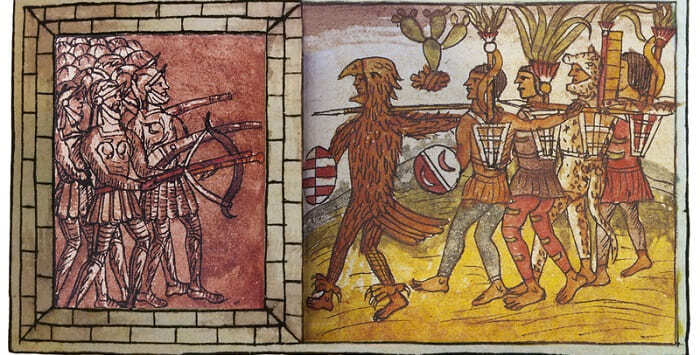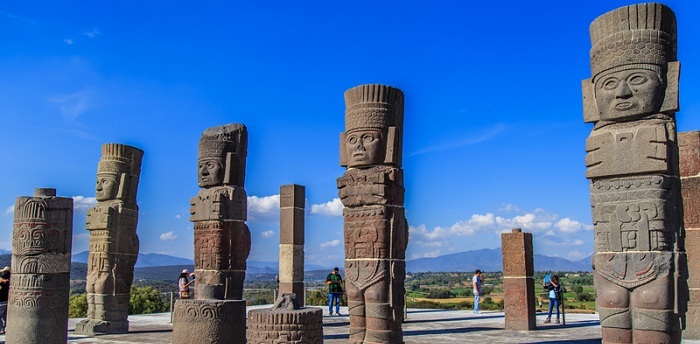

The Aztec Empire was one of the most powerful and sophisticated civilizations of the pre-Columbian era, and their military prowess played a critical role in their success. The Aztecs had a complex system of warfare, with a well-organized army and a sophisticated arsenal of weapons and armor.
In Aztec mythology, the gods played a key role in determining the outcome of battles. For example, the god Huitzilopochtli was the patron god of war, and was believed to lead the Aztec armies into battle. The Aztecs believed that they were the chosen people of Huitzilopochtli, and that their success in battle was a sign of his favor.

In addition to the gods, the Aztecs believed in the importance of sacrifice in warfare. Captives were often taken in battle, and many of these captives were sacrificed to the gods in elaborate ceremonies. The Aztecs believed that these sacrifices were necessary to ensure the success of their military campaigns.
The Aztec army was a well-organized and disciplined fighting force. The Aztecs had a complex system of conscription, with every male citizen required to serve in the army for a certain period of time. The army was organized into different units, with each unit having a specific role to play in battle. For example, there were units of archers, units of spearmen, and units of warriors armed with macuahuitl, a wooden sword with obsidian blades.

The Aztecs also had a system of military hierarchy, with officers appointed based on their experience and skill. The highest ranking officer was the tlatoani, or emperor, who was in charge of the entire army. The Aztecs also had specialized units, such as the eagle warriors and the jaguar warriors, who were elite soldiers known for their bravery and skill in battle.
The Aztecs had a sophisticated arsenal of weapons and armor. The macuahuitl was one of the most common weapons used by Aztec warriors. This weapon was made of wood and had obsidian blades embedded in the edges. The obsidian blades were razor sharp and could cut through bone and metal. The macuahuitl was a versatile weapon that could be used for both slashing and thrusting attacks.
One of the most common strategies was the use of ambushes. Aztec warriors would often lie in wait for their enemies and then launch a surprise attack. The Aztecs also used diversionary tactics, such as sending a small group of soldiers to draw their enemies away from their main force.
The Aztecs also used psychological warfare to intimidate their enemies. For example, they would often wear elaborate headdresses and costumes in battle to make themselves appear more fearsome. They also used war cries and battle songs to intimidate their enemies.
The Flowery Wars were a series of battles fought between the Aztecs and their neighbors in the late 15th and early 16th centuries. These wars were not fought for the purpose of conquering territory or resources, but rather as a form of ritual combat.The Flowery Wars were named for the flowers that were used in the ceremonies surrounding the battles.
When the Aztecs emerged victorious in battle, they would take captives and loot from their enemies. The captives would be sacrificed to the gods, while the loot would be distributed among the victorious soldiers and their leaders.
The Victor's Spoils were an important part of Aztec warfare, and were used as a way of rewarding soldiers for their bravery and skill in battle. However, the practice also had a darker side, as it incentivized the Aztecs to engage in aggressive military campaigns for the purpose of obtaining captives and loot.
Despite their military prowess, the Aztecs were ultimately unable to withstand the forces of the Spanish Conquistadors, who arrived in Mexico in the early 16th century. The Conquistadors had superior weapons and technology, and were able to exploit the internal divisions within the Aztec Empire to defeat them.
In conclusion, Aztec warfare was a complex and sophisticated system that played a critical role in the success of the Aztec Empire. The legacy of Aztec warfare lives on, however, in the rich cultural heritage of the indigenous peoples of Mexico and the Americas.
Q1. Did the Aztecs use ranged weapons in battle?
Ans. Yes, the Aztecs had a variety of ranged weapons, including the atlatl (a type of spear-thrower), bows and arrows, and slings. These weapons allowed them to attack their enemies from a distance, before engaging them in close combat.
Q2. What was the role of priests in Aztec warfare?
Ans. Priests played an important role in Aztec warfare, as they were responsible for conducting the rituals and ceremonies that surrounded battles. They also played a key role in sacrificing captives, which was an important part of the Aztec religious tradition.
Q3. What was the role of women in Aztec warfare?
Ans. Although women were not allowed to serve as soldiers in the Aztec army, they played an important role in supporting the war effort. Women were responsible for weaving the cotton armor worn by soldiers, as well as preparing food and supplies for the army. They also participated in religious ceremonies and rituals that were associated with warfare.